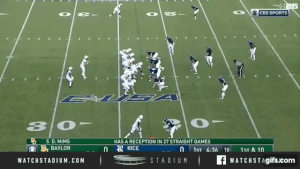Rice football embarks on conference play this week, but first, there’s some film break down. This week Carter tackles three key plays.
Hey y’all, it’s time for the Rice Football Film Room again! This week we’re gonna look at a couple plays from Rice’s game last week against Baylor, breaking down an early defensive highlight from Blaze Alldredge (of course) and then Tom Stewart’s late touchdown run to put Rice within a score. Then we’ll look at an early play from Louisiana Tech’s win over FIU in Week 4, to show the improvement in their run game, spearheaded by RB Justin Henderson.
BAYLOR
Blaze Alldredge—Defensive End?

Setup
It’s Baylor ball, 4:36 left in the first quarter, 1st and 10 on the Rice 23, no score. Baylor is in 12 personnel, with the QB in the gun and the back behind and to his right. There’s an inline TE on each side of the line, with the one on the right being No. 91 Rob Saulin, a 6-foot-5, 302-pound behemoth whom Baylor lists as a “TE/DT” on their roster.
Notice, though, that Saulin is “covered up”—the wide receiver to the boundary is also on the line of scrimmage. That means that Saulin is not an eligible receiver; only players on the ends of the line of scrimmage and in the backfield are eligible on passing plays. So if this ends up being a pass, Saulin cannot get more than three yards down the field; the formation (and indeed his very presence on the field) suggests that this is probably going to be a run play.
Rice has a normal group of personnel out there, but as is DC Brian Smith’s wont, they’re in some unusual spots. Anthony Ekpe is playing the Viper position instead of his usual Rush OLB. Typical starting Viper Treshawn Chamberlain is standing directly behind MLB Antonio Montero at the snap. And WLB Blaze Alldredge is on the boundary side of the defensive line with his hand in the dirt as a defensive end.
The Play
It is indeed a running play, and in fact, it’s GT Counter, the same play I highlighted for Baylor in last week’s Film Room. The only difference is that they’re in 12 personnel instead of 11, with a backside TE (Saulin) to help seal off the DE (in this case Alldredge).
But the 302-pound Saulin isn’t nearly fast enough to block Blaze Alldredge, who knifes inside through the C-gap at the snap and meets the back five yards behind the line of scrimmage for a TFL. Even if Saulin manages to slow him down or block him completely, this play was probably doomed for Baylor regardless. Take a look at the pullers: the guard gets his block on Rice DE Jacob Doddridge, but Antonio Montero slips by the tackle, who lunges for him and falls. Maybe the RB would have managed to reverse direction, but in that case, one of Alldredge, Myles Adams, or Isaiah Richardson (No. 23 for Rice) would have probably made the play.
Ramblin’ Tom Scores Again!

Setup
Rice ball, 8:49 to go in the fourth quarter, 1st and 10 from the Baylor 21, Baylor leading 21-6. Rice is in 12 personnel, with Stewart in the pistol, Jaeger Bull and Jordan Myers lined up at H-back, Austin Trammell and Brad Rozner split wide, and Austin Walter as the RB.
Baylor is in 3-3-5 personnel, with all three linebackers bunched up close to the line. Note that Rice has numbers in the run game: seven blockers to six in the box. If Rice can get a hat on a hat, Baylor will need its DBs to play extremely aggressively in run support to stop this play.
The Play
The play is meant to look like split zone—a running play that’s similar to inside zone, except that the frontside H-back (in this case, Myers) runs parallel to the line for what’s called a slice block to help seal off the backside. Right tackle Brandt Peterson climbs to the second level, chipping a linebacker before passing him off to Bull and heading further downfield. Bull engages with that linebacker, leaving the defensive end unblocked initially. The end, thinking it’s split zone, slips inside of Myers to make the tackle on Walter (if it were actually split zone, the end would be Myers’s responsibility on the slice block).
Except it’s not split zone—it’s good ol’ inside zone read, with the added wrinkle that Myers is actually doing an arc block instead of a slice block. The end crashes inside to go for Walter, and it’s an easy read for Tom Stewart to pull the ball, with Myers now essentially lead-blocking for him. Myers, seeing that the linebacker has pushed his way past Bull, moves in to double team him, clearing the way for Stewart to get the edge.
More: The Roost Podcast Ep 9 – Baylor Review and LA Tech Preview
Now it’s up to one of Baylor’s three interior DBs to make the play, since Rozner’s vertical route has cleared the cornerback. No. 1 and No. 8 take themselves out of the play because they don’t realize that Stewart has the ball and not Walter! The man in the middle, No. 3, correctly diagnoses the play but Peterson does an excellent job to square him up in the open field, and by the time he disengages Stewart is already past him.
I think the only players on the field Tom Stewart is faster than is his own offensive line, but this is now his second 10-plus yard zone read touchdown on the year. RUN IT TILL THEY FEAR YOU, TOM.
LOUISIANA TECH
Henderson Off to the Races

The Setup
9:36 left in the first half and FIU and Louisiana Tech are locked in a 3-3 tie. It’s Tech ball at the FIU 29, 2nd and 5. The Bulldogs are in 10 personnel, with two receivers split wide to either side and QB J’Mar Smith in the shotgun with RB Justin Henderson. FIU is showing a 4-2-5 look, with a single high safety out of view (looks like they’re in Cover 3).
The Play
It’s a tackle-lead option run, though not one I’m familiar enough with to know of a universally-accepted name for. It’s not exactly zone read because the tackle pulls, but it’s maybe closer to that than tackle-power read, because power read usually involves reading the edge defender on the front side of the line of scrimmage (that is, the side that the puller is heading for).
Names aside, it’s easy to see how the play works. The tackle pulls to lead the way if it’s a handoff, leaving his defender unblocked for the QB to read. For the QB, then, it’s exactly like zone read: if the end stays home, hand it off. If he crashes, pull the ball.
In this case, the end does what’s called “slow playing” the option. He doesn’t exactly crash, but he sort of shuffles his feet while keeping his shoulders parallel to the line. The idea is to muddle the QB’s read, slow his decision-making, and be in a position to make the tackle regardless of who gets the ball. Normally a QB should react to this by handing the ball off, because that’s the quicker-hitting play. That’s what Smith does, although the end gets so far inside by the time they’re at the mesh point that a more athletic QB (no offense to Smith, but his career YPC is 2.6) probably could have pulled it and beaten him around the backside.
More: Check out the game preview for Rice vs Louisiana Tech
The OL has done its job (the LG, in particular, does a stellar job of getting leverage and turning his man toward the sideline), and there’s a big hole for Henderson to run through. But in this case, the end’s slow play has worked to perfection and he’s there to make the play. One of FIU’s DTs, who’s engaged with the RG, also manages to free an arm in time to grab Henderson as he runs through the hole.
Justin Henderson has other ideas, however. He simultaneously breaks free of both the end (who should have him dead to rights) and the DT’s attempted arm tackle, stiff arms another defender, accelerates, bounces the run outside, and scores to give Tech the lead.
No doubt Louisiana Tech’s offense will run primarily on the arm of Smith, but Henderson’s emergence in the run game gives them a new tool to maintain balance on offense. Rice’s front seven will need to continue to wrap up and gang tackle as well as they did in nonconference play to keep the Bulldogs off schedule and behind the chains.

